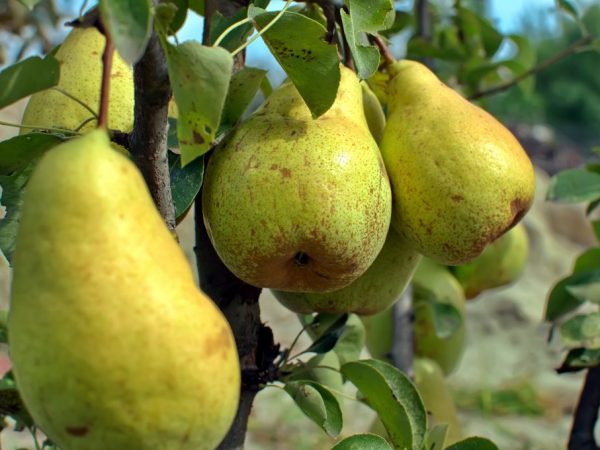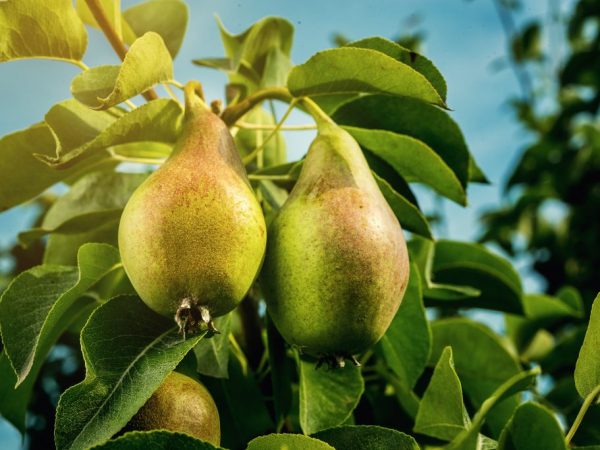Characteristics of the Kieffer pear
Pear Kieffer is a hybrid variety from the USA. Belongs to fruits of the category of autumn ripening. The myth says that the variety was bred by chance in 1864 from the seed of a Chinese pear, pollinated with pollen. The author of the variety is the famous gardener Peter Kieffer. The variety does not lose popularity even after 150 years, which proves its reliability.

Characteristics of the Kieffer pear
Variety characteristic
The variety is in demand due to its numerous advantages:
- has a high yield;
- has early maturity;
- resistant to disease.
The disadvantages include:
- poor winter hardiness;
- second-rate fruit taste;
- low shelf life.
It is widely used in the North Caucasus region and in Ukraine. Due to the fact that the variety is very resistant to diseases, it is used to breed new varieties. For better pollination, it is advised to plant another seedling of a different variety next to such a fruit tree.
Description of the tree
By the type of trunk, which reaches an average height, the variety is classified as fast-growing. The crown has the shape of a pyramid. The trunk of the tree is gray, covered with minor cracks. The branches are the color of wet asphalt and are located at sharp angles to the trunk (26-31 degrees). It blooms in early spring, pollinators are needed to maintain life. Begins to bear fruit in three to four years. The usual height is 3-4 m.
Leaves are ovate, with a pointed end, rich green color with a short petiole. In autumn, they acquire a crimson color, which undoubtedly decorates the garden. The plate is smooth, thick, and twisted upward.
Description of fruits
Most often, the fruits are of medium size, but there are exceptions in the form of large specimens, reaching 400 grams in size. The fruits are more like apples. They are tied in several pieces per inflorescence and firmly adhere to the tree. The average fruit size ranges from 150-200 gr. Well transportable. The shape resembles quince and apples.
The pear has a dry, dense and rough skin. The fruit, which was on the sunny side, is covered with crimson dots. The stalk is not long, thickened on both sides.
Sapling selection
The choice of a seedling is a very crucial step; future resistance to diseases and fertility may depend on it. In order to choose a seedling, you need to follow some rules:
- it is worth choosing an unbranched seedling up to 1 year old with a height of less than 130cm with a trunk girth of ~ 9mm;
- a one-year-old branched seedling should be 50 - 65 cm, with a trunk diameter of about 10 - 12 mm, and a branch length of about 75 mm;
- at the age of two years, the seedling should grow up to 65 cm in height and have a diameter of ~ 15 mm, branches ~ 175 mm;
- it is preferable to buy seedlings from trusted sellers.
Having planted a three-year-old seedling, you should not count on 100% survival rate.
Care

The tree needs good care
The Kieffer pear variety needs careful maintenance, which includes:
- top dressing;
- mulching;
- watering;
- pruning and crown formation.
Compliance with the rules of care allows you to get a generous and high-quality harvest.
Top dressing
In autumn, all fruit and fruit varieties of plants need more minerals. In any garden center you can buy a mineral complex for fruit crops. In the spring, the seedling needs nitrogen fertilizers. The best are ammonium nitrate and urea.
Once every five years, you need to feed the tree with potassium, phosphates and lime. Feed with nitrogen fertilizers each year before flowering. At the end of summer, if you wish, you can feed the tree with a solution of phosphorus and potassium, but not more than 150 ml.
Mulching
If the tree is planted on depleted land, mulching will undoubtedly help, which will keep the soil fluffy, enrich with useful substances and help defeat weeds.
Place mulch on warm soil and chop thoroughly before laying. If the layer has survived the winter, remove it to warm the soil. Most often, bark, sawdust, needles and cones are used as mulch.
Watering
Watering usually occurs 3 times a season. You need to pay attention to the weather conditions, in case of drought, about 7 buckets of water may be required. At the end of autumn, dig a small hole around and fill it with water, so the root system will be provided with moisture. Repeat the procedure, preferably three times.
To keep the water from spilling out, make small borders around the hole. Before watering, take some soil and squeeze it to check the condition. If the humidity is high, reduce the number of buckets to 5.
Avoid the most common mistake - watering near the trunk. The tree should be watered under the crown.
Crown pruning
The tree needs pruning, it is necessary to form a multi-tiered by 4 years. To do this, you need to cut the conductor. You also need to remove and bend the side shoots to avoid thickening of the crown. It is desirable to carry out circumcision before sap flow. It is advised to remove infected or rotten fruits.
In summer and winter, it is better not to do pruning. Weather conditions during these seasons will not allow the saw cut to drag out, which will significantly weaken the plant.
At the beginning, you need to cut off diseased broken branches. In the next period, pruning is needed in order to prolong fruiting, for this you need to cut out some of the unnecessary skeletal branches. You need to pay attention to diseased branches and cut them as soon as they appear.
Pests and diseases
In the description of the Kieffer pear, good immunity to diseases is indicated, but this does not mean the variety does not need to be cared for. It is recommended to treat the pear with a salt mixture, since the wasps do not allow the fruit to retain the nutrients, as a result of which the fruit will rot. It is imperative to process the crown with Fufafon so that worms do not start. To protect the plant from scab and damage to pears, you need to regularly pluck the damaged fruits from the branches. It is important to regularly clear weeds from the near-stem soil in order to avoid the breeding of the gypsy moth.
Conclusion
Pear Kieffer is unpretentious, which is what many gardeners like. It is necessary to monitor the state of the culture to obtain the maximum and tasty yield. The fruit helps to increase immunity, helps fight colds, has an anti-inflammatory effect, and soothes coughs. Pear compote will help remove unnecessary toxins from the body. Remember that it is pointless to plant a tree in winter, it does not tolerate cold very well.


